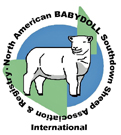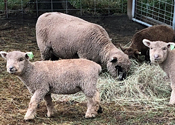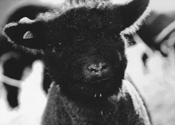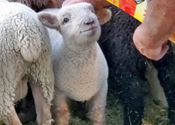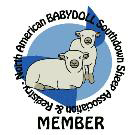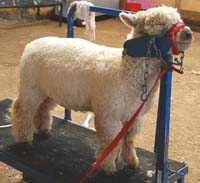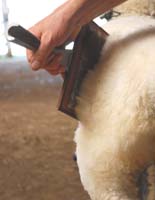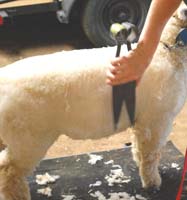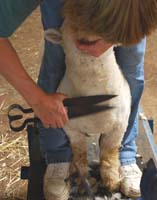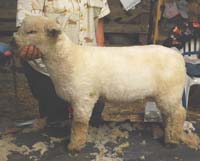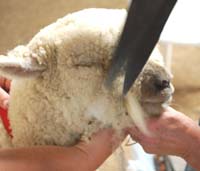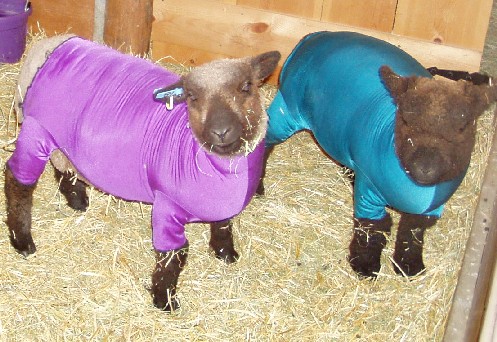It can be beneficial to learn more about the show you plan to attend by picking up a rule book or meeting the Superintendent running the sheep show to learn the fitting rules in your area. Attend a fair or sheep show and observe how people are fitting their sheep. It is much easier to learn by seeing than reading; especially how to hold the hand shears and what the finished sheep should look like. Fitted sheep and sheep running free on grass look a lot different. If someone has never really seen fitted sheep, it is hard for them to visualize how the sheep should look when prepped for the show ring.
Sheep intended for breeding or grown for wool, like BABYDOLLS, are typically shown in fleece. Sheep raised for their meat and entered in the market classes are seen in fleece or slick sheared. The idea behind slick shearing is it makes conformation and muscling obvious while leaving your sheep in fleece allows you to use wool to enhance these features.
When showing in fleece it is very impressive to Spot-shear, Block-out, or Cutout the wool. This is when you shear your sheep but leave wool longer on the top line, butt, legs and poll. Top lines can be gradually fitted down a little at a time. The extra wool allows you to accentuate your lamb's attributes. However, this process begins 6-8 weeks before the show. The goal is to level the tops and hips while giving the animal eye appeal from the side profile.
One week before the show wash your sheep. Although not necessary, a blocking stand really saves your back and helps restrain your sheep. (Figure 1) Hot water does a better job of breaking the grease and lifting the dirt. Blue Dawn dish soap has the highest alcohol content so many feel it cuts the lanolin the best, getting the sheep the cleanest. Foamers work best for even soap application or soap mixed with hot water. Sheep are rinsed from top to bottom, front to back. Be sure to completely rinse out sheep or you will end up with a green-fleeced sheep. Shammies are helpful to take the excess water out of the sheep after rinsing. A dog brush can be used to take the knots and crimp out of the fleece. A currycomb is used to break down the fleece for easier carding. Be sure to deep card the fleece to facilitate the drying process and to help the fit job hold better after fitting. If a blower is used, blow at an angle as to not knot the fleece. Then card the fleece well before blanketing and placing sheep in a clean well-bedded pen.
Two days before the show, or when the sheep are dry, fitting can begin. Dampen wool before fitting using a spray bottle or a wrung wet rag with just water. Hold card hand flat on top using a corner-to corner action to pull and straighten wool fiber. (Figure 2) Carding is an important step to get a smooth fit on the lamb. It is also important not to rip card. It is painful to your sheep and will make the fleece uneven.
The goal is to make a sheep look longer bodied, longer necked, and flatter hipped. When it is time to start trimming, you can use hand shears or electric shears. Start on the left side in case you make a mistake, as this is the side the judge tends to see less of. Work from the front to back with smooth strokes. Try to keep your thumb still and use your fingers to pull the blade toward you when using hand shears. (Figure 3) Carding more and blending can correct mistakes.
Top line: To cut the top out on a sheep with hand shears or electric shears, start at the high point of the loin and go out through the rump to create a level dock. Then a line is created from the top of the withers to the loin to establish a level top line. A good top line length when finished is 1/2".
Body: Make belly sides flat. Take extra off shoulders and front legs to give the impression of well laid in shoulders where many BABYDOLLS are weak. Either shear or clip wool off belly to give impression of a long flat body. Blend belly line. Belly wool should be slick shorn to 1/2" and sides 3/4 to 1".
Legs: Card the rear legs and shape to make muscling look large and blended. Trim inside of the front legs to make straight, outside of ankles to make leg look straight, rear leg hair, card then shape slightly around to look leggy and straight. Finished leg fleece should be about 3/4 to 1 in length. Trim hooves even a week prior at washing.
Tail: Cut short and makes a level cut to bottom of tail to make impression of a wide and deep rear. A small narrow indentation line from bottom of tail (vulva in females) to bottom of twist should be made to accentuate depth of twist and to make the fitted legs look fuller.
Head, neck and shoulders: Wool blended and cheeks sheared to make muzzle blend, top of head and ear set blend in an almost level line. Neck blends into shoulder. Brisket cut in flat on bottom and straight down from under chin. (Figure 4) To make broad and give head set look good, long neck etc.
The sheep should be carded and trimmed with hand shears and cutout a multitude of times until the desired look is accomplished. (Figure 5)
End product is a straight lined sheep with a similar line on the underline as the top line. Finish the finer details with a hand shearer for smoother finish. (Figure 6) To be a successful fitter one must card the sheep a lot. The only way to a smooth finished product without having cracks in your fleece on show day is to card. Lamb Jammies (Figure 7) really keep them clean until show time and cost about $15.
A
NOTE ABOUT BIO-SECURITY
Bio-security reduces and helps prevent the spread of infectious
diseases to your farm. Please take precautions so you do not bring
anything back to your farm. Disinfect shoes and show equipment, and
keep show animals separated from the rest of your flock.
